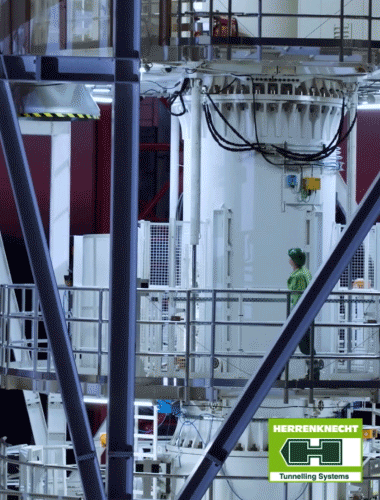WSSC water tunnel pushing progress
Jan 2012
Paula Wallis, TunnelTalk
- Excavation is moving forward on the Bi-County Water Tunnel in the suburbs of Washington DC following a series of setbacks last year that delayed progress on the Renda/Southland/SAK JV contract.
- "Some of the best advance rates to date were achieved in the final quarter of last year, and 2012 is starting out well," said Steve Pinault, Project Manager for the Owner, Washington Suburban Sanitary Commission (WSSC). "Tunneling is in good competent rock at the moment and the TBM is performing well. So far the best daily advance rate by the Renda/Southland/SAK crews is 131ft (40m) and the average has been about 350ft a week since mining resumed in July 2011."
- Excavation stopped in late February 2011 for four months to complete major repairs on the used Robbins main beam gripper TBM. The 10.6ft (3.2m) diameter machine had just completed its first drive of 4,124ft (1,257m) from Connecticut Avenue east to the Stoneybrook Shaft (Fig 1), and was about 1,000ft (305m) into its second and longest drive west to the Tuckerman Shaft when it broke down The pinion gear in the number two gearbox failed and the other three gearboxes and the bull gear were damage.
-

Fig 1. Alignment of the Bi-County Water Tunnel
- Robbins provided full technical assistance to rebuild and improve the damaged machine to minimize future potential risk, and initially performed refurbishing of the cutterhead and cutterhead bearing support, while the contractor Renda/Southland/SAK JV and other suppliers fabricated the trailing gear and other components for the project.
- The TBM was back in the ground by the end of June, but in early August hit a section of fractured ground. "The TBM was about 2,600ft (792.5m) into the westward drive from the Connecticut Shaft when excavation halted for about three weeks while steel sets were ordered and installed to support the Class III ground," said Pinault. "A small section of rock collapsed creating a void of about 8ft (2.4m) deep in the tunnel crown. The TBM suffered minor damage, mostly to the main beam conveyor belt and motor."
- Pinault said the steel sets are holding the ground and there has been no further movement. The TBM cleared the section of poor ground and has made steady progress ever since in mostly Class I ground.
- Work began on the $112.5 million deep hard rock tunnel in the summer of 2009. The water supply tunnel is designed by Black & Veatch to meet future demands in the suburban Washington DC area. The Jacobs Associates/Engineering Science and Technology JV holds the construction management contract.
- "There is still a long way to go to complete the 4.5 mile drive to the Tuckerman Shaft, but the project is progressing well and excavation of the total 5.3 miles or 28,000ft (8,500m) of tunneling is more than 13,000ft (3,962m) or about 47% complete," said Pinault. "Time was lost due to the TBM repairs last year and the section of challenging ground, but the contractor hopes to make some of that up. Water inflows are lower than anticipated at around 400gal/min and change orders are still below 1% of the fixed-price contract."
- Elsewhere on the project installation of the 84in diameter steel carrier pipe is set to begin soon and will progress back from the Stoneybrook Shaft to the Connecticut Avenue Shaft.
- Excavation is complete on the Tuckerman Shaft where work will begin this summer to tie-in to the existing 96in diameter pipe and construct the new valve vault. At Stoneybrook Shaft, the major connections between the existing main, vault and shaft are completed and the shaft has been backfilled. The surface work, except for restoration, is also complete.
- Barring any unforeseen challenges, the Bi-County Water Tunnel is on schedule to be in service by the first quarter of 2014.
- TBM breakdown has Bi-County Tunnel on hold - TunnelTalk, Mar 2011
|
|
|
|
|
Add your comment
- Thank you for taking the time to share your thoughts and comments. You share in the wider tunnelling community, so please keep your comments smart and civil. Don't attack other readers personally, and keep your language professional.






